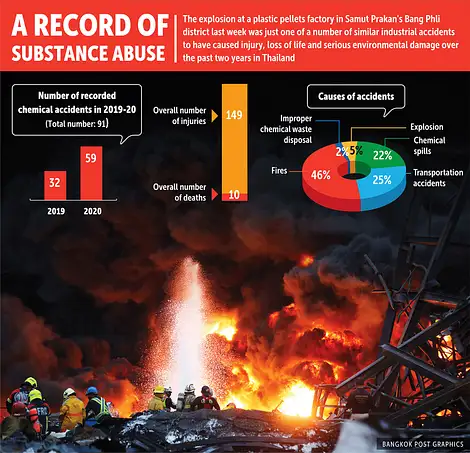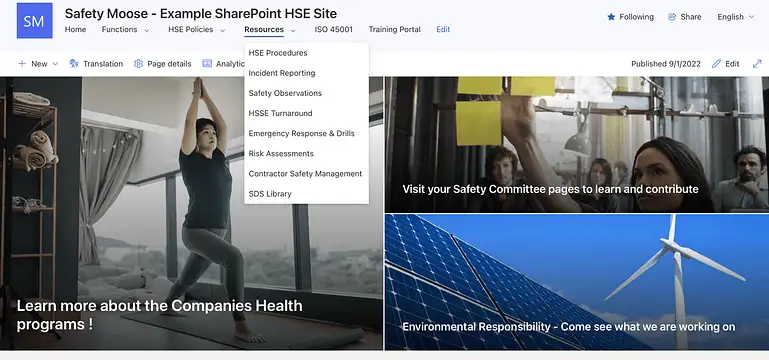Thailand updates the Occupational Health & Safety Law in the wake of the 2021 Styrene explosion that killed one volunteer fireman and seriously injured 29 more people.
Many homes nearby were damaged or destroyed and there still isn’t a true accounting of how many are suffering adverse health as a result of breathing the toxic smoke from the fire, which burned for more than 15 hours.
Although there is no public report that we are aware of, detailing the causes of this disaster, the government has made changes to the laws on the importation, storage and use of hazardous chemicals, that were implemented last year. This applies to all industries, even if they are not operating in established industrial estates.
These new moves to beef up the occupational safety laws are definitely a step in the right direction, especially within the hazardous industries. 54 Industry sectors are affected.
As a further step, the Ministry of Labour has recently made some notable changes to the OSH Act of 2011 and the revision has now passed into law, effective June 10th, 2022.
Thailand doesn’t have a comprehensive database of regulations like OSHA or the HSE so there isn’t a lot of information available. All we have are the various laws related to OSH, which can be quite daunting to read and understand.

Key Takeaways from Occupational Health & Safety Law updates
- The law applies to 54 industries (listed below)
- For each of these industries, companies (or juristic entities) with 50 or more employees will need to comply
- Companies will need to provide evidence of having effective Safety Management Systems in place that follow international standards.
- There is a new requirement in the law to include a “security” component in your safety policy and procedures.
- There are penalties for non-compliance. Including possible jail time! (see below)
Companies need to apply a standards approach to their occupational safety and health programs
These are usually based around Plan Do Check Act (PDCA) methodologies, however the translation of the law doesn’t stipulate that you must be certified, only that a recognised standard is applied and can be demonstrated. Below is what the law references for acceptable standards to follow:
Occupational Health & Safety Law – Clause 13 Standard Safety Management System:
- ISO Standards (in the case of OHS, you would follow ISO45001)
- International Labor Organization (ILO) – The ILO do not issue a specific written OSH standard or set of procedures, so this isn’t much help to the entrepreneur.
- Standards based around the British Standards Institute (BSI) – standardization, systems assessment, product certification, training and advisory services. Notch help if you are developing a SMS. Its interesting that the new law doesn’t mention the UK’s Health & Safety Executive, which is the UK’s version of OSHA!
- Standards based around the American “Occupational Safety and Health Administration” (OSHA) – this is most definitely a well written set of safety regulations that you can use, however keep in mind that Thai regulations will supersede those of OSHA (i.e. work at height).
- Thai Institute of Standards (TISA) – most the are doing work that is related to quality standards assessments.
- American National Standards Institute (ANSI) – again, this organisation can’t really help you to build a safety management system but can provide various other standards.
- Australia Standards/New Zealand Standards (AS/NZS) – voluntary technical and commercial standards which are sometimes adopted by occupational safety and health regulations.
- Canadian Standards Association (CSA) – Standards Development and in Testing, Inspection and Certification around the world.
How to be compliant with new Law
So from the above list, if you want to develop a Safety Management System, your best bet is to model yourself on the ISO45001 program or OSHA (which can be complicated).
The other standards listed won’t help you to design a Safety Management System that would make you compliant with the Law

Once again, to be clear, the law does not say that you MUST gain certification of any kind, it just says you need to have a program in place that follows a standard.
Occupational Health & Safety Law – The Safety Management System must at least contain:
- A written Occupational Safety, Health and Environment policy that is properly communicated to all interested parties.
- Evidence of a system of Management of safety, health and the working environment.
- Work plans & procedures related to OSH&E that are put into practice. This must be formally reviewed at least annually
- Evidence of training programs and continual improvements
- Evaluation and review of the security management system. This is a new addition and isn’t very specific on the requirements.
- Continual improvement and development of the safety management system.
- A process of incident investigation and reporting.
The above isn’t all inclusive so I suggest that you obtain a copy of the law and review it yourself.
Management of the Safety Management System
Based on the updated Law, the employer of the establishment is required to:
- Supervise the operation according to the safety management system (Leadership component of ISO standards and others)
- Provide opportunities for all employees to participate in the implementation of the safety management system. (also a key aspect of ISO and other standards)
- Provide employees with access to information related to the security management system, taking into account the protection of personal information. I am not too clear what this means because it came from a Google translation. This requirement may relate to the privacy of medical records and other sensitive data.
- Provide a channel for receiving opinions, suggestions or complaints about safety, occupational health and/or the working environment of employees. There must be a procedure in place to review these employee suggestions and look for continual improvement. If you have an intranet, I suggest you use Google Forms. Works great.
Occupational Health & Safety Law: 54 Industries Sectors Affected
Below is the full list of industries that will be affected by this law. The law applies to those companies with 50+ employees (including contractors working at your work site, not just full time employees).
The list below is a translation of the section of law using Google translate, so it may look a little strange.
1. Mining industry according to the law on minerals
2. Petroleum business industry under the law on petroleum
3. Petrochemical industry
4. Petroleum refining industry
5. Industry related to natural gas separation
6. Publishing Industry
7. Food products industry
8. Beverage Industry
9. Tobacco Products Industry
10. Textile industry
11. T-shirt industry cloth or clothing
12. Leather industry
13. Wood products industry
14. Paper industry or products processed from paper
15. Chemical or chemical manufacturing industry
16. Pharmaceutical industry or medical supplies
17. Rubber Product Industry
18. Plastic products industry
19. Non-metallic mineral products industry
20. Metal industry or metal products
21. Electronic equipment industry
22. Electrical appliances or electrical equipment industry
23. Machinery or machine tool industry
24. Vehicle industry, vehicle parts or accessories for vehicles
25. Furniture Industry
26. Jewelry Industry
27. Musical Instrument Industry
28. Sports equipment industry
29. Toy Industry
30. Medical device and equipment industry
31. Power generation, transmission or distribution industry
32. Gas production or packaging industry
33. Coke production industry
34. Industry of production, storage or distribution of steam
35. The licking industry slaughter or cultivation
36. Service stations under the law on fuel oil trade
37. Fuel oil depot according to the law on fuel oil control
38. Wastewater treatment or waste disposal services
39. Industry of reusing used materials
40. Mineral dressing industry Mining or panning minerals according to the law on minerals
41. Construction, modification, repair or demolition of buildings
42. Transportation Industry
43. Air navigation services under the law on air navigation
44. Warehouse business, silo business, or cold storage business
45. Telecommunications
46. Installation, repair or maintenance of machinery
47. Hotels
48. Condominium juristic entities
49. Department stores, retail businesses or wholesale business
50. Convention and Exhibition Centers
51. Hospitals
52. Testing and analysis of physical, chemical, biological or engineering operations
53. Sale and maintenance of motor vehicles or repair of motor vehicles
54. Zoo’s or amusement parks
Penalties for Non-Compliance of the Occupational Health & Safety Law
Any entrepreneur who fails to procure the well-recognized standard or arrange the safety management systemsunder this Ministerial Regulation shall be liable for imprisonment for a term of not exceeding one (1) year and/or a fine not exceeding Baht 400,000 (Four Hundred Thousand Baht only). This liability may extend to directors, managers, or any other responsible parties of the entrepreneur who is a juristic person. [translated with Google translate]
A Safety Management System that will Comply with Thai Law
Ashlar can design an ISO 45001 style Safety Management System (SMS) built on your existing SharePoint subscription which come with most Microsoft 365 Business Subscription plans. Best of all, it can be in your local language and be used on both mobile and desktop.
This SMS, because its built around the ISO45001 standard, can not only bring your company 100% into compliance with Thai OSH Laws, it can also prepare you to try for a full ISO certification in the future. Its out of the box ready but you and your team will still have to ensure the system is followed. We can also help with that.


